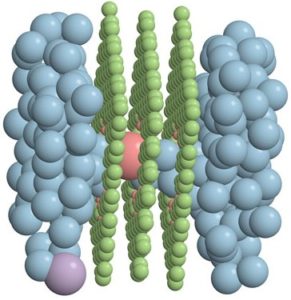
Scientists are using supercomputers to help understand the relatively rare event of salts in water (blue) passing through atomically-thin nanoporous membranes. A traversing chloride ion (peach) induces charge anisotropy at its rear (e.g., the light purple sodium ion in the bottom left), which pulls it backward.
In this TACC podcat, host Jorge Salazar discusses ion transport research with Amir Haji-Akbari, an assistant professor of chemical and environmental engineering at Yale University.
Scientists are using supercomputers to help understand the relatively rare event of salts in water passing through atomically-thin nanoporous membranes. This research could not only help make progress in desalination for fresh water; it has applications in decontaminating the environment, better pharmaceuticals, and more.
For scientists, natural systems can try one’s patience. For a long time, nothing. Then all of a sudden, something. Wonderful things in nature can burst on the scene after long periods of dullness – rare events such as protein folding, chemical reactions, or even the seeding of clouds. Path sampling techniques employ computer algorithms that deal with the dullness in data by focusing on transitions.
Advanced path sampling techniques and molecular dynamics (MD) simulations captured the kinetics of solute transport through nanoporous membranes, according to a study published online in the Cell journal Matter, January 2020. A nanopore is basically a tiny molecule-sized hole only a few nanometers across.
The goal was to be able to calculate the mean first passage times for solutes irrespective of their magnitude,” said study co-author Amir Haji-Akbari. “Supercomputers are extremely useful in addressing questions that we can’t address with regular computing resources. For example, we couldn’t have done this calculation without a supercomputer. They’re extremely valuable in accessing scales that are not accessible to either experiments, because of their lack of resolution; or simulations, because you need a large number of computer nodes and processors to be able to address that.”
The study, “Induced Charge Anisotropy: A Hidden Variable Affecting Ion Transport through Membranes,” was published online in the Cell journal Matter in January 2020. The study co-authors are Hessam Malmir of NASA Ames Research Center; Razi Epsztein of the Israel Institute of Technology; Menachem Elimelech and Amir Haji-Akbari of Yale University. The National Science Foundation funded the study.




